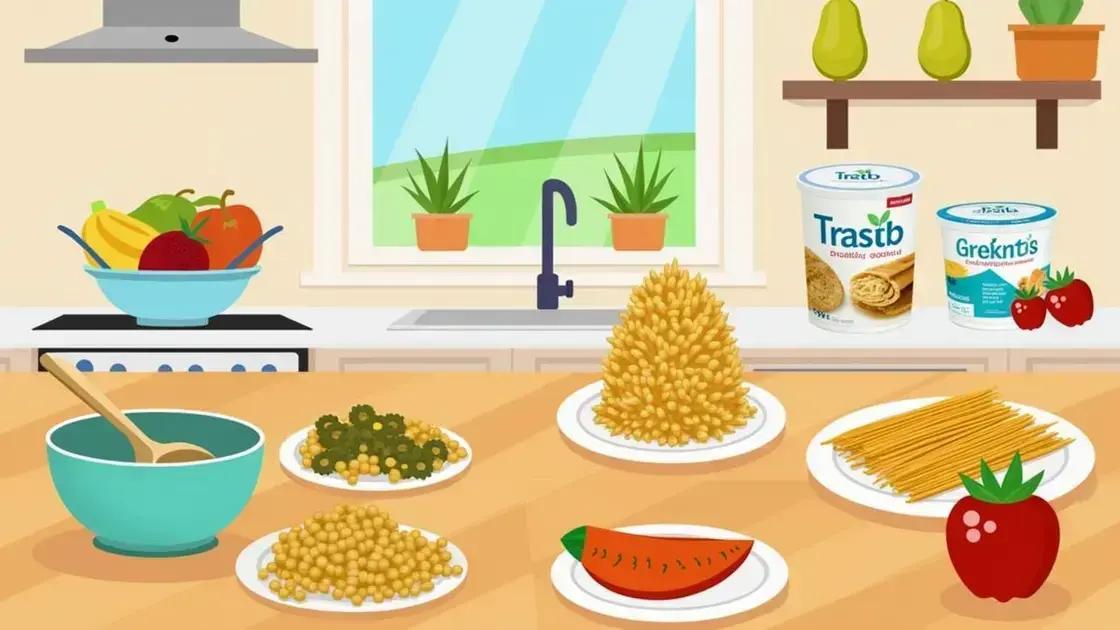Making simple swaps for healthier food choices involves replacing less nutritious ingredients with better alternatives, meal planning effectively, and understanding the numerous benefits of a healthier diet, such as improved nutrition, weight management, and increased energy levels.
Making simple swaps for healthier food choices can significantly improve your diet and overall health. By understanding how to replace common ingredients with healthier options, you can enjoy delicious meals without sacrificing nutrition. In this article, we will explore various alternatives, offer meal planning tips, and discuss the benefits of incorporating these changes into your lifestyle. Let’s dive into the world of healthy eating!
Understanding Simple Swaps

Understanding simple swaps is the first step to making healthier food choices. In our daily meals, we often use ingredients that can be replaced with better options. These swaps are not only easy but can also enhance the nutritional value of your meals.
Examples of Simple Swaps
For instance, instead of using white rice, consider brown rice or quinoa. These alternatives are richer in fiber and nutrients. Similarly, you can replace regular pasta with whole grain or vegetable-based pasta for a healthier option. Even switching to olive oil instead of butter can provide healthier fats for your body.
Reading Labels for Better Choices
When shopping for food, it’s essential to read labels carefully. Look for ingredients with fewer additives and higher nutritional content. This simple practice can help you identify better food choices. Remember, if a product has a long list of ingredients you can’t pronounce, it may be best to choose another option.
Making Swaps at Home
You can also make swaps at home. For example, swap out sour cream with Greek yogurt for a creamy texture with added protein. Additionally, using natural sweeteners like honey or maple syrup instead of refined sugar can enhance the taste while being healthier.
Creating a List of Swaps
Creating a list of your favorite simple swaps can be incredibly helpful. Keep this list handy while grocery shopping or planning meals. As you try new swaps, you’ll find that healthy eating can be both tasty and satisfying. Experimenting with different ingredients can make your meals much more enjoyable!
Healthy Ingredient Alternatives

Choosing healthy ingredient alternatives can significantly improve your diet. Here are some great swaps to consider:
Flours
Instead of white flour, try using whole wheat flour, almond flour, or coconut flour. These options are higher in fiber and nutrients, making your baked goods more nutritious.
Milk Options
If you are looking to replace cow’s milk, almond milk, soy milk, or oat milk are excellent alternatives. These choices often contain fewer calories and can be fortified with vitamins and minerals.
Sugars
When sweetening your meals, swap white sugar with alternatives like honey, maple syrup, or stevia. Natural sweeteners have a lower glycemic index, which can help maintain steady energy levels.
Meat Substitutes
For those reducing meat intake, consider using lentils, chickpeas, or tofu as protein sources. These plant-based options are rich in nutrients and can provide the protein your body needs.
Butter and Oils
Replace butter with mashed avocado or applesauce in baking for healthier fats. Additionally, use olive oil or avocado oil instead of vegetable oil for a heart-healthy cooking option.
Snack Alternatives
For snacks, consider swapping chips with air-popped popcorn or veggie sticks with hummus. These alternatives are lower in calories and packed with nutrients, keeping you satisfied.
Tips for Meal Planning

Meal planning is crucial for making healthier food choices. Here are some helpful tips to get started:
1. Set Aside Time Each Week
Choose a specific day each week to plan your meals. This consistency makes it easier to stay organized and ensures you have everything you need.
2. Create a Balanced Menu
Focus on creating a balanced menu. Include a variety of proteins, whole grains, fruits, and vegetables. Aim to cover different food groups to ensure you get essential nutrients.
3. Use a Meal Planning Template
Consider using a meal planning template or app. Writing down your meals can help keep you accountable and organized. A template will also help you visualize what you need for the week.
4. Choose Simple Recipes
When selecting recipes, choose simple and quick meals. This approach saves time and makes cooking less overwhelming. Look for recipes with fewer ingredients that you enjoy.
5. Prepare Ingredients in Advance
To save time during the week, prepare ingredients in advance. Chop vegetables, marinate proteins, or cook grains ahead of time. This preparation allows for quick meal assembly.
6. Keep a Grocery List
As you plan meals, create a grocery list to ensure you have everything you need. Stick to the list when shopping to avoid impulse purchases and focus on healthy options.
7. Be Flexible
While meal planning is important, be flexible. If plans change or you don’t feel like eating what you planned, adjust as needed. The goal is to make healthy eating manageable.
Benefits of Healthier Food Choices

Choosing healthier food options can lead to numerous benefits for your body and mind. Here are some of the benefits:
1. Improved Nutritional Intake
Healthier food choices are often packed with essential nutrients like vitamins, minerals, and antioxidants. These nutrients are crucial for overall health and can improve your body’s functioning.
2. Weight Management
Making simple swaps helps in managing weight effectively. Foods with less sugar and unhealthy fats can help reduce calorie intake, promoting a healthy weight.
3. Increased Energy Levels
Eating nutrient-rich foods can boost your energy levels throughout the day. Whole grains, fruits, and vegetables provide sustained energy, keeping you active and alert.
4. Better Digestion
Healthier food choices often include higher fiber content, which is beneficial for digestion. Foods like fruits, vegetables, and whole grains can help maintain gut health.
5. Reduced Risk of Chronic Diseases
By making healthier food choices, you can lower the risk of chronic diseases such as heart disease, diabetes, and obesity. A balanced diet contributes to long-term health.
6. Improved Mood
Nutrition plays a role in your mood and mental health. Eating whole, nutritious foods can enhance brain function and may help reduce feelings of stress and anxiety.
7. Better Skin Health
What you eat can affect your skin. Foods rich in antioxidants, vitamins, and healthy fats can promote healthy skin and improve your complexion.
Embracing Healthier Food Choices
Making simple swaps for healthier food choices is a beneficial journey that can lead to significant improvements in your overall health and well-being. The benefits include improved nutritional intake, better weight management, increased energy levels, and a reduced risk of chronic diseases.
By understanding simple swaps, utilizing healthy ingredient alternatives, and following effective meal planning tips, you can create a diet that fuels your body and boosts your mood.
Incorporating these healthy habits into your lifestyle will not only enhance your physical health but will also foster a positive outlook on life. Start today and watch how small changes can lead to a healthier, happier you.
FAQ – Frequently Asked Questions about How to Make Simple Swaps for Healthier Food Choices
What are simple swaps for healthier food choices?
Simple swaps are easy substitutions you can make in your diet, such as replacing white rice with brown rice or using Greek yogurt instead of sour cream.
How can I meal plan effectively?
To meal plan effectively, set aside time each week to choose balanced meals, create a grocery list, and prepare ingredients in advance.
What are some healthy ingredient alternatives?
Healthy ingredient alternatives include using whole wheat flour instead of white flour, almond milk instead of cow’s milk, and natural sweeteners instead of refined sugar.
What are the benefits of making healthier food choices?
Benefits include improved nutritional intake, weight management, increased energy levels, better digestion, and a reduced risk of chronic diseases.
How can I stay motivated to eat healthier?
Staying motivated can be easier when you set specific goals, keep healthy snacks available, and try new recipes to keep things interesting.












